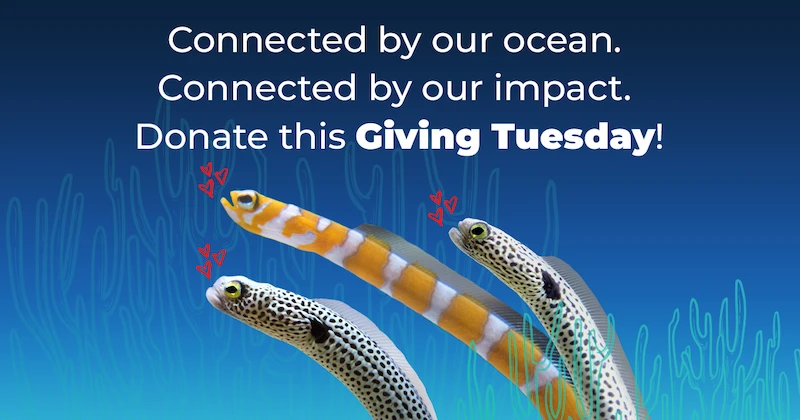Famously beautiful and fiercely important, coral reefs are bursting with many different forms of life, making them hubs of biodiversity. With the opening of our Ocean Pavilion expansion, the Seattle Aquarium will say hello to The Reef, a multistory habitat that mirrors an Indo-Pacific coral reef. Its warm waters will house fish, including sharks and rays. This thriving reef ecosystem will also be visible to anyone walking by the Aquarium via the building’s public oculus window.
But what does it take to transform a slice of downtown Seattle into a tropical reef? A lot, it turns out.

Planning it out
With the Ocean Pavilion, Aquarium leaders wanted to create a window into the Coral Triangle, a region of unmatched marine biodiversity in the Indo-Pacific. Guests would experience both the stunning natural beauty of the area and learn more about the connections between the Coral Triangle and our local marine ecosystems—and the challenges both regions face. After the experience, guests would be motivated to take action to regenerate the health of Earth’s one ocean.
Throughout the Aquarium’s years-long planning process, the decision of which animals could live in The Reef and how to design the habitat were intertwined. Over several years the Aquarium’s animal care, engineering, and engagement teams worked alongside the Ocean Pavilion architect (LMN) and habitat designer (Thinc) teams to create environments that support animal wellbeing and facilitate connections between the animals and guests.
That collaborative process resulted in plans for The Reef to include an open swimming area, crevices created by corals and rockwork, and flat, sandy enclaves. Each area provides critical habitats for the different tropical animals that comprise a reef ecosystem. The open swimming area gives animals, including spotted eagle rays and other cartilaginous fish known as elasmobranchs, plenty of room to move freely. The sandy areas give bottom-dwelling elasmobranchs, like Indo-Pacific leopard sharks, a place to rest. And the corals and rocks—including a large rock wall near a central viewing window—provide the kinds of protective spaces that smaller fish naturally seek out.

Populating The Reef
Our teams designed The Reef with the animals in mind. Animal care experts knew the habitat would need to support resident species throughout their lives. And all these different species needed to coexist, so large predator species would not be a good fit. Finally, we focused on getting these animals through sustainable means. All of the elasmobranchs in The Reef came from other zoos and aquariums or were diverted from the commercial fish trade.
Corals presented an animal care concern. Reef-building stony corals need an intense amount of light, which is difficult to simulate and maintain deep in an aquarium habitat. Stony corals also need water with high levels of calcium and other supplements, which is challenging to replicate in a closed environment with other animals. Ultimately, the team chose to include only handmade corals in The Reef, representing about 40 different species. Over 30 species of living corals will occupy other habitats in the Ocean Pavilion where they can safely thrive.
The animal care work for the Ocean Pavilion began over two years ago when the first animals came to the Aquarium’s off-site Animal Care Center. Since then, our aquarists have become very familiar with the needs of these fishes, invertebrates (animals without backbones) and even mangrove trees!

Prepping the habitat
Unlike our habitats at Piers 59 and 60, the Ocean Pavilion has a closed loop system, meaning once water enters the building, it generally stays and recirculates. The water comes in from Elliott Bay and completes a treatment process that includes heating, filtration and disinfection so it can safely mimic the water found in the Coral Triangle. But before animals can safely swim in the water, a different group of organisms needs to set up shop: bacteria!

Two different types of nitrifying bacteria break down ammonia-rich animal waste. The first type transforms ammonia into nitrites. The second turns nitrites into nitrates, which are safer to have around. The Aquarium’s Water Quality team cultivated populations of these bacteria in about a month by creating the ideal conditions for them to reproduce and thrive.
Before animals enter the habitat, the Engineering team thoroughly tests elements of the life support systems, which maintain all habitats and water throughout the building. These tests make sure the temperature regulation, filters, pumps, pipes and more run smoothly. The team always has failsafe redundancies built into habitat systems and backup plans in case of an emergency to ensure animal wellbeing.

Moving in
Habitat? Check. Water? Check. Systems? Check. Time for the animals!
The team starts by carefully planning the transport of each animal to the Animal Care Center so they can quarantine. This is an important time to help the animals settle into their temporary habitats and assess their health status.
When fish are ready to move into The Reef, the team starts by introducing groups of small schooling fishes. These smaller fish need ample time to get to know their new home and find the hiding spots where they feel most comfortable. Then we move on to introducing larger fishes, with the elasmobranchs brought in later in the lineup.
Moving animals into The Reef is an unhurried, carefully monitored process. Each new addition requires a period of observation to make sure the animals are adjusting well. Once the animal care, veterinary, water quality and engineering teams agree that the animals and the habitat are doing well, the next wave of animals can come in.
This highly involved process can take weeks or even months, but it is the best way to ensure animal wellbeing.
Protecting wild coral
The Reef at the Ocean Pavilion may have taken years to come together, but wild coral reefs take even longer. Large reef systems, like barriers and atolls, can take millions of years to fully form.
Reef-building corals—which are animals that live in large groups called colonies—use calcium carbonate to build their stony skeletons. Build rates vary from species to species, but in the Coral Triangle, even the fastest corals add less than an inch per year to their skeletons.

Despite the fact that they take up less than 1% of the seafloor, coral reefs are incredibly important marine ecosystems. They support about 25% of known marine life, providing crucial habitat space and other resources. Humans benefit too because these reefs protect shorelines and provide food, medicine and more. Unfortunately, corals face many threats including climate change, rising ocean temperatures, pollution and unsustainable fishing practices.
When you visit the Ocean Pavilion, you’ll experience the wonder of coral reefs and learn more about how people around the world are working to restore these ecosystems. No matter where you are, from the Coral Triangle to the Salish Sea and beyond, you can join them today.
To reduce your carbon footprint, try walking or taking public transit. You can even pick up litter when you see it on the beach. Keep our waterways clean by limiting fertilizer usage in your greenspaces. Some sunscreens have chemicals that hurt corals. Choose reef-safe formulas to protect yourself and corals! Visit our Act for the ocean page to learn more.


